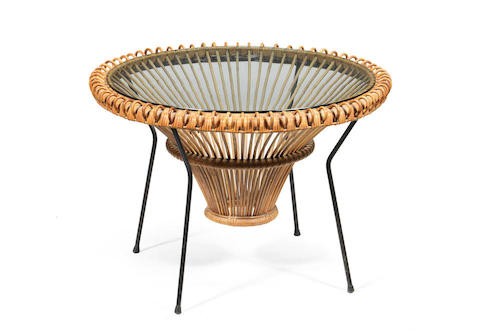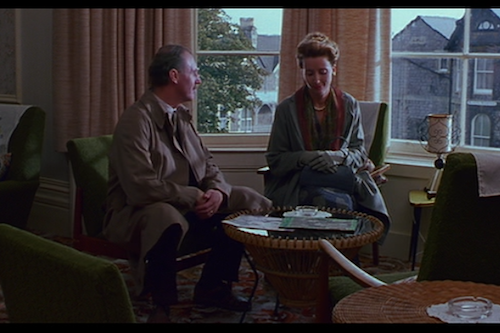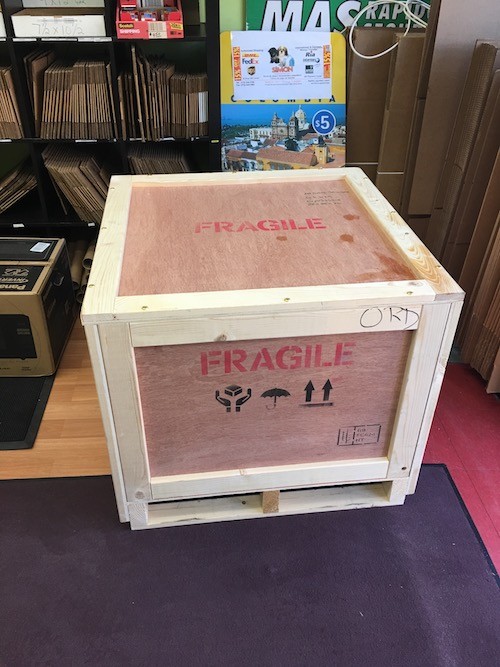
On December 10, 1962, Sylvia Plath moved from Court Green, her home in Devon, England, to a flat at 23 Fitzroy Road in London. That she had been able to rent this particular flat had great significance for her, as one of her idols, W.B. Yeats, had once lived there. The following day, December 11, Plath purchased furniture for her new residence. At Selfridges department store she bought two chairs, a table, and several bar stools. According to her checkbook stub,* she paid £19:1:0 for these items, roughly 394 pounds by today’s inflation rate, or 520 US dollars. The furniture was delivered within ten days. In a December 21 letter to her mother, Plath wrote:
I have never been so happy in my life. By some miracle everybody has delivered and done everything for me before Christmas . . . I have fresh white walls in the lounge, pine bookcases, rush matting which looks very fine with my straw Hong Kong chairs and the little glass-topped table, also straw and black iron in which I can put flowerpots and currently have a lilac hyacinth.
As we now know, Plath was far from happy in her new flat. Exactly nine weeks after she moved into 23 Fitzroy Road, she committed suicide in the early hours of February 11.
Fast-forward 55 years: I receive the catalog for the Sylvia Plath and Ted Hughes auction that will take place on March 21, 2018 at Bonhams in London. Frieda Hughes had decided to sell some of her parents’ property—inscribed books, jewelry and clothing, furniture—so that others might “take on the preservation and enjoyment of things that I have loved to live with, but which I would like to find new homes for.” As I flipped through the catalog, I stopped at Lot 346: “A circular cane and glass top occasional table, from Heals, on slender metal legs.” The description also stated that Plath had bought the table when she was living at Court Green, between 1961 and 1962.
Because I was familiar with her December 21, 1962 letter to her mother, I immediately recognized this as “the little glass-topped table, also straw and black iron.” I also knew that the description was incorrect: Plath had bought the table in London, not when she was living at Court Green, and at Selfridges not Heal’s. And because I was familiar with her checkbook stubs, I knew the precise date Plath had purchased it. I was astonished: This piece of furniture was in the apartment in which Plath spent her final weeks, and in which she died. Had she sat next to it in one of her “Hong Kong” chairs? Had she set drinks on it, or a book she was reading, or a poem she was working on? I wondered if anyone else would ascertain its provenance. I wondered if I would actually bid on it.
A week or so before the auction, I happened to watch, for the first time, the 1993 movie The Remains of the Day. Since Sylvia’s table was on my mind, I noticed, in a scene between Emma Thompson and Tim Pigott-Smith, a duplicate of the table. The scene takes place in the early sixties, so the set director had done an accurate job. It’s exactly the kind of bamboo or wicker (Plath called it “straw”) furniture one would have seen at that time. I took this table-sighting as a sign. I had to bid. Moreover, I was beginning to believe that the table was destined to be mine.
On March 21, I followed the auction online. I’d placed a maximum bid with Bonhams the day before. My confidence—and my excitement—grew as I watched other furniture lots end at what I thought were reasonable prices. By the time Lot 346 came up, my heart was racing. Unlike the previous furniture lots, the price on “the little glass-topped table” quickly shot up. In no time, it reached my maximum bid. Then paused. I held my breath. I’m going to win it, I thought. But then I was outbid by three hundred pounds, and the auction abruptly ended. I was stunned; I was so certain I was meant to get it.
My disappointment passed fairly quickly. It dawned on me that I could look for a duplicate. It wouldn’t be Sylvia’s table, but it would reflect her spirit, as well as her taste. It only took a few minutes on Google to determine that the table was created by mid-century Italian designer Franco Albini. He also designed a rattan bucket chair that matched the table. Were Plath’s “Hong Kong” chairs by Albini, too? In and of themselves, Albini pieces are highly collectible. A duplicate table would not cost as much as my maximum bid, but it wouldn’t be cheap. I found a couple of tables identical to Plath’s on eBay; both were pretty timeworn. Sylvia’s table had obviously been treated with care.
“Miracles occur,” says Sylvia. A week after the auction, I received an email from Bonhams wanting to know if I was still interested in the table. The high bidder had over-extended herself in the heat of the auction. She was having second thoughts and wished to offer it to me. And so, on April 19, Sylvia’s table arrived at the postal service where I receive my mail (a couple of blocks from where I live) in a 102-pound, museum-quality wooden crate (shipping was a third of the total cost). The crate was too bulky and heavy for me to transport, so we removed the lid (using a power screwdriver) and lifted out the table, which was mummified in plastic wrapping. I borrowed a cart and wheeled it home. Luckily it was a clear spring day. The padding made the table too wide to fit through my door, so I unwrapped it in front of the house. After the table was safely inside, I walked to a nearby nursery and bought a pot of lilac hyacinths, just as Sylvia had done, so it would feel at home. Four days later, Peter K. Steinberg, co-editor of The Letters of Sylvia Plath, came to Chicago to give a lecture at Columbia College. I brought him to my house—the first friend to “visit” and photograph the table. To date, poets Tony Trigilio and Suzanne Buffam have also had close encounters with it.
I’ve had the table for several months and still haven’t removed the Bonhams tag with the lot number (“346”) on it. I may never. And I may never understand why I had to have it, or should I say “why I was meant to have it.” I recognized the significance of it, and that seemed to attach me to it. I’ve joked with friends that I might put my Ouija board on it and see what happens, but I don’t know that I’d ever have the nerve. When the table arrived, I was in the process of reading all of Yeats’s poems. I felt a mystical kinship, sitting next to the table reading Yeats. In the nineties, during a trip to London, I made a pilgrimage to 23 Fitzroy Road. There’s a photograph of me standing on the steps, underneath the commemorative plaque that says Yeats once lived at that address. I of course placed Yeats’s Collected Poems on the round glass tabletop, next to a few Plath titles. I’m currently rereading all of her poems. I won’t deny that the table has a powerful vibration. Suddenly the furniture in my living room paled; IKEA wasn’t good enough for it. So I ordered new and better furniture: midnight blue couch, green armchair, a rattan “Hong Kong” chair that “rhymes” with Sylvia’s table. Now I wonder: What more will it want from me?
*Plath’s checkbook stubs are in Plath’s papers at Smith College.
David Trinidad is the author of more than a dozen books, including Peyton Place: A Haiku Soap Opera ...
Read Full Biography








